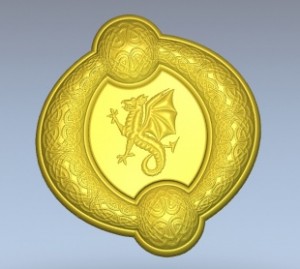3D tools added to ArtCAM Insignia artistic CADCAM
Delcam has added 3D modelling tools to ArtCAM Insignia
A range of 3D modelling tools have been added to Delcam’s ArtCAM Insignia software for volume production of artistic items by signmakers, furniture manufacturers, engravers and sculptors of materials from wood or metal to ice.
Like all the members of the ArtCAM family of software, Insignia allows artistic users to produce high-quality decorative items, with all the productivity and consistency benefits of computer-based manufacturing but without the need for any detailed engineering knowledge. A demonstration version is now available for download, with a series of online webinars showing the new functionality planned for 20th January. Full details are available on the ArtCAM Insignia website www.artcaminsignia.com.
Within the new 3D modelling tools, the most powerful option is the Shape Editor. By simply double clicking on a specific colour of a bitmap image or a selected vector, the user can quickly transform it into a 3D design. The Shape Editor can not only determine the shape’s profile, angle and height but also how it is combined with any 3D relief that has already been created.
A second method for creating 3D designs from vector art is the Two-Rail Sweep. By selecting multiple vectors for the edges of the shape and any number of cross sections for chosen positions, users can quickly create a 3D sweep shape or a swept surface.
Once the initial design has been created it can be edited in a number of ways. The surface of the model can be given a smooth, unblemished appearance with the Smooth Relief tool. Options are available to smooth over the entire 3D design, an area within a specific vector or a selected colour, in a number of passes. This is a particularly useful way of smoothing evenly across a scanned 3D model for example.
Areas of the design can also be smoothed with the Smooth Sculpting tool. This can be used to remove blemishes from a scanned 3D model, to smooth adjoining areas of multiple pieces of relief clipart, or to soften sharp edges or corners. The final option can be particularly useful for designers of dies for foil stamping or embossing as softer corners can prevent the die from ripping the material.
Any mistakes made during smoothing can be overcome with the Erase tool, which allows the user to sculpt back to a previous point in time. The same tool can also be used to sculpt areas down to a flat surface.
Textures can be added to all or part of the relief to give a more attractive design, or to provide backgrounds on embossing plates or signs. Networks of shapes, such as spheres, cones, pyramids and weaves, can be added or subtracted to any colour and vector, or to the entire 3D model. Alternatively, files can be imported to create the required texture.
The complete relief can be offset, either to hollow out the part or to create the wall thickness. The same option can be used in toolmaking, either to produce the core and cavity of a mould, to create a male punch or to generate the shape required for a master for vacuum-formed packaging.
The 3D relief can also be wrapped along the x or y axis to create a cylindrical-shaped design, for example, a chair leg, 3D sculpture or rotary embossing die. This data can then be used to create the toolpath to rotary machine the design. Most designs created in ArtCAM Insignia are expected to be machined with the range of 3D strategies in the software. However, the software also offers the ability to create triangle meshes, which can then be exported in a number of common 3D model file formats. This data can be sent to rapid prototyping equipment or to CAD systems, like DelcamÕs PowerSHAPE modeller, where the relief can be used to decorate a CAD model.




